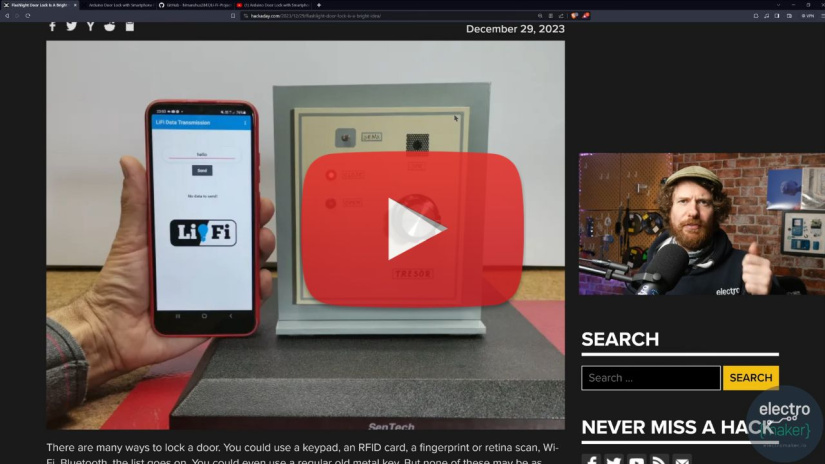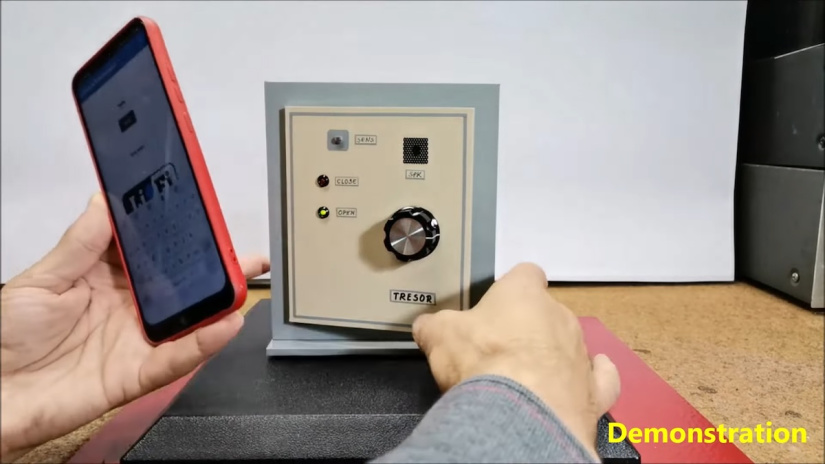Arduino & Li-Fi: A New Era of Secure Door Lock Technology
Could this be the cutting-edge intersection of DIY electronics and home security? An Arduino-based door lock system that's as clever as it is unconventional. At the heart of this innovation is the work of Mirko Pavleski, known in the maker community as mircemk on Hackaday. His project, a brilliant blend of simplicity and sophistication, leverages the power of Arduino to transform a smartphone's flashlight into a secure key.

Watch Ian talk about the Arduino door lock project
But there's more to this project than just an Arduino and a flashlight. It intricately intertwines with Himanshu Sharma's Li-Fi project, an innovative venture that explores the potential of light fidelity (Li-Fi) technology. This collaboration marks a unique foray into using light as a means of secure communication, particularly in the context of a door lock mechanism.
What sets this project apart is not just its use of everyday technology, but how it reimagines the role of light in security. The idea of using a smartphone's flash as a key is an interesting example of how traditional security measures are being rethought in creative and accessible ways.
Concept and Design of the Flashlight Door Lock
The core concept of this innovative door lock is surprisingly straightforward yet ingenious: using a smartphone's flashlight as a digital key. This approach transforms a common feature found in most smartphones into a secure unlocking mechanism. The idea is simple – the flashlight emits a specific light pattern, which is then interpreted as a key by the lock system.

The Arduino door lock project in action!
At the heart of this system lies an Arduino board, the brain behind the operation. The Arduino is configured to work in tandem with a Light Dependent Resistor (LDR). The LDR acts as a sensor, detecting and measuring the intensity of the light emitted by the smartphone's flashlight. This setup allows the Arduino to interpret the varying light patterns as digital signals, effectively turning them into a unique key for the door lock.
Completing the design is a solenoid, a critical component in the locking mechanism. The solenoid acts as an actuator, which is controlled by the Arduino. When the correct light pattern is detected by the LDR, the Arduino triggers the solenoid, which in turn unlocks the door. This seamless integration of the solenoid with the Arduino and LDR showcases the potential of combining simple electronic components to create sophisticated and secure systems.
The Security Aspect: More Than Meets the Eye
The secret to its security lies in the precision of the light flash required to unlock the door. The system doesn't just recognize any light; it requires a specific pattern of light flashes, timed with millisecond accuracy. This level of precision means that the light pattern is incredibly difficult to replicate without the correct sequence and timing, making it a robust security feature.

Arduino door lock with smartphone light - the guts of the project!
Enhancing this security further is the complexity of the light patterns themselves. The Arduino and LDR setup is programmed to recognize a vast array of unique light sequences, each corresponding to a different 'key'. This complexity not only makes it challenging for unauthorized individuals to guess the correct pattern but also allows for a high degree of customization in setting up personal 'light keys'. It's a brilliant example of how a simple concept, when executed with precision and creativity, can result in a highly secure system.
The Li-Fi Project: A Crucial Component
Integral to the functionality of this innovative door lock is Himanshu Sharma's Li-Fi project. Li-Fi, or Light Fidelity, represents a paradigm shift in data transmission, using light to convey information. Sharma's project explores this technology's potential, laying the groundwork for its application in various domains, including security.
The Li-Fi app, a cornerstone of Sharma's project, is ingeniously utilized in the door lock system. It generates precise light signals, which are then used as keys for the lock. The app allows the user to input a passcode, which is then translated into a unique sequence of light flashes. These flashes, with their millisecond precision, are detected by the door lock's LDR, interfaced with the Arduino.

Arduino Door Lock with Smartphone Flashlight - schematic diagram
This interplay between the app's passcode and the Arduino system forms the crux of the locking mechanism. The Arduino is programmed to recognize the specific light pattern associated with the correct passcode. When the LDR senses this pattern, the Arduino triggers the solenoid, unlocking the door.
Did You Enjoy This Article?
Don't miss out on the latest trends, projects, and tips in DIY electronics and tech. Make sure to subscribe to our monthly newsletter for regular updates and insights delivered straight to your inbox. Stay connected with a community of innovators and enthusiasts who are reshaping the world of technology, one project at a time.













































